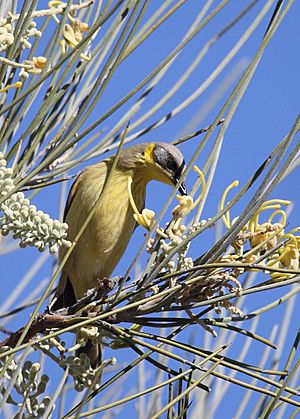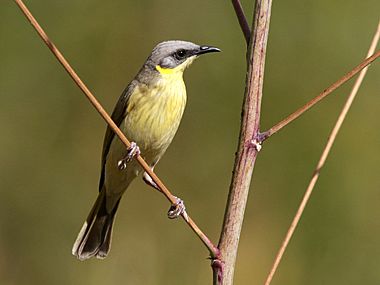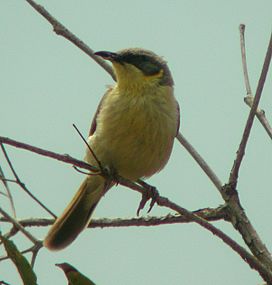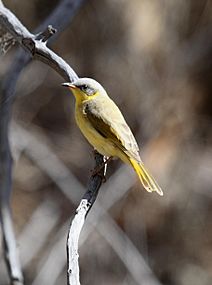Grey-headed honeyeater facts for kids
Quick facts for kids Grey-headed honeyeater |
|
|---|---|
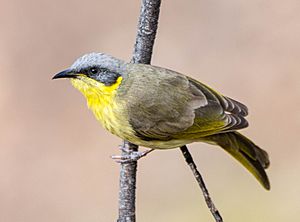 |
|
| At Trephina Gorge, Northern Territory | |
| Conservation status | |
| Scientific classification | |
| Genus: |
Ptilotula
|
| Species: |
keartlandi
|
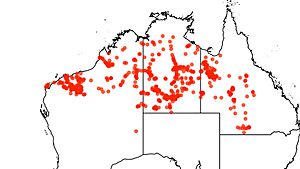 |
|
| Location records from Ebird data available to the Atlas of Living Australia under Creative Commons Zero (CC0). | |
| Synonyms | |
|
Lichenostomus keartlandi |
|
The grey-headed honeyeater (Ptilotula keartlandi) is a type of bird that belongs to the honeyeater family (Meliphagidae). This bird is found only in Australia.
Contents
About the Grey-headed Honeyeater's Name
The grey-headed honeyeater was first described in 1895 by an Australian bird expert named Alfred John North. He named the bird after George Arthur Keartland, who was a collector of bird specimens.
Over the years, scientists have changed which group (or genus) this bird belongs to several times. It was once in the Meliphaga group, then Lichenostomus. Now, it's placed in the Ptilotula group. This group includes five other Australian birds. They all have plain faces and a special yellow or white feather patch on the side of their neck. The name Ptilotula comes from old Greek words meaning "feather" and "ear".
Scientists believe that all birds in the Ptilotula group came from a common ancestor. This ancestor lived in the dry woodlands of central Australia a very long time ago.
What Does the Grey-headed Honeyeater Look Like?
Grey-headed honeyeaters are fairly small birds. They are about 13 to 16.5 centimeters (5 to 6.5 inches) long. They weigh about 12 to 18 grams (0.4 to 0.6 ounces). Their wings are about 6.7 to 8.1 cm long, and their tail is about 5.5 to 6.9 cm long. Their beak is about 1.45 to 1.85 cm long.
Adult birds have a special look. They have a grey top of the head and a black mask on their face. This mask covers their eyes and goes back to their ears. Below the mask, there's a thin, bright yellow feather patch. They also have a pale yellow stripe near their throat.
Their beak is black and curves slightly downwards. The bottom part of the beak is yellow, but it can turn completely black when they are breeding. Their eyes are dark brown or black. The skin at the corner of their mouth (called the gape) is yellow, but it also turns black during breeding.
The chest, belly, and throat of the bird are light olive-yellow with brown streaks. Their back is light grey-brown. The feathers on their wings are olive-brown with yellow edges. This makes their folded wings look like they have a yellow stripe. Their tail feathers are dark olive-brown with olive-yellow edges.
Male and female grey-headed honeyeaters look the same in terms of their feathers. However, males are usually a little heavier and bigger than females. Their feather colors do not change depending on where they live in Australia.
Young grey-headed honeyeaters (juveniles) look similar to adults. But they are usually paler. Their face mask is a lighter grey-brown. Their beaks are grey-black with an orange-brown base. Their gapes are yellow, and their head is a lighter grey. Young birds change their feathers (called moulting) as they grow. They keep some of their tail and wing feathers from when they were very young. They get their full adult feathers in their first year.
The grey-headed honeyeater makes a continuous "chip" sound when it eats. It also sings a "wee-wee-wee" song. Other sounds include a loud "kwoyt" and "chee-toyt," which they might only make when breeding.
Where Do Grey-headed Honeyeaters Live?
The grey-headed honeyeater lives in a very large area across central Australia. This area includes dry and semi-dry regions. The total area where they are found is about 4.36 million square kilometers.
These birds mostly live in Eucalyptus forests and woodlands. They prefer stony hills and wooded valleys. However, you can also see them on sandy plains when plants are flowering. They have also been seen in mulga and mallee woodlands. Sometimes, they are found near rivers with River Red Gum trees. They can even be found in certain grasslands.
Grey-headed honeyeaters usually stay in one place (they are sedentary). But they do move around to find flowering plants. These movements are usually local. However, some birds have traveled long distances. For example, one bird was seen 270 kilometers north of its usual area after many Eucalyptus trees flowered.
How Grey-headed Honeyeaters Live
What They Eat and How They Behave
The grey-headed honeyeater finds invertebrates (like insects) on leaves and branches. They also catch insects while flying. Like many honeyeaters, they drink nectar from flowering trees. They especially like hakeas, eucalypts, grevilleas, and mallee trees. They have also been known to eat fruit sometimes.
You usually see grey-headed honeyeaters alone or in pairs. But sometimes, small groups of 5 to 20 birds gather around a good food source. These birds are active, noisy, curious, and can be quite feisty. They sometimes fight with other honeyeaters or even other birds. They might make territorial calls, snap their beaks, chase, or fight. This happens when they are feeding and possibly when they are breeding.
Reproduction and Life Cycle
Scientists don't know a lot about how grey-headed honeyeaters breed. They think breeding mostly happens in winter and spring. However, it might happen at any time of year, especially after it rains.
They build their Nests low in a living tree or bush. Nests are often found in dry creek beds or banks, but usually not near water. The nest is a small, open, cup-shaped structure. It's made from dried plant stems, grass, and bark, held together with spider webs. The inside of the nest is lined with soft plant material, feathers, and animal hair. The nest hangs from the tree or bush.
They usually lay two eggs. The eggs are described as oval, rounded, shiny or dull, and white or pink. Sometimes they have light brown or purple spots. We don't know how long the eggs take to hatch. It's thought that they only raise one group of chicks each year. Both male and female birds have been seen trying to distract predators when someone gets too close to their nest.
Protecting the Grey-headed Honeyeater
Conservation Status
The grey-headed honeyeater is listed as "Least Concern" by the IUCN (International Union for Conservation of Nature). This means they are not currently considered to be in danger. Their population seems stable, and they live in a very large area. Australian laws also consider them "Least Concern."
Threats to the Species
Even though their population seems stable, scientists don't know exactly how many grey-headed honeyeaters there are. They are thought to be uncommon or only found in small numbers in some areas. This suggests they might not live in high densities.
Sometimes, predators eat their nests or other birds lay their eggs in the honeyeater's nest (called nest parasitism). However, there isn't enough information to know if these are big problems for the species.
The grey-headed honeyeater might be affected by climate change. Because of what they eat and how they rely on rainfall for breeding, changes in climate could make it harder for them to find food or breed. This could cause their habitat to shrink or become unsuitable for them.
What is Being Done to Help
The IUCN hasn't listed any specific actions to protect the grey-headed honeyeater. However, general actions to help Australian birds might also help this species. These include:
- Better land management.
- Buying land to protect it.
- Creating new habitats.
- Improving the quality of existing habitats.
Also, the grey-headed honeyeater lives in some protected areas. These include refuges run by the Australian Wildlife Conservancy (like Newhaven, Bowra, and Pungalina) and several National Parks. The management actions in these areas can also help the grey-headed honeyeater.
Gallery
See also
 In Spanish: Mielero cabecigrís para niños
In Spanish: Mielero cabecigrís para niños



